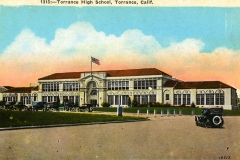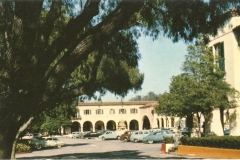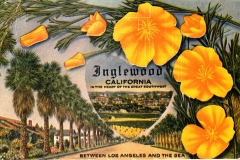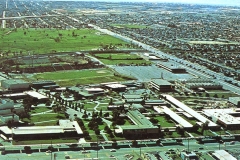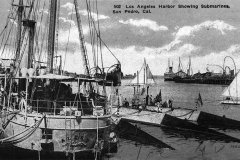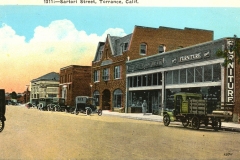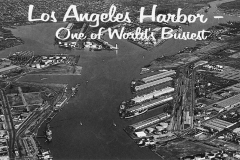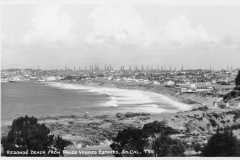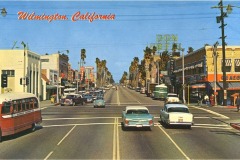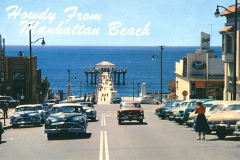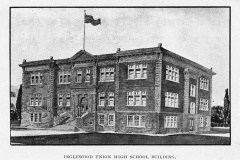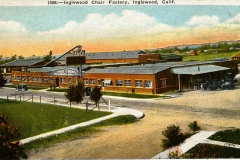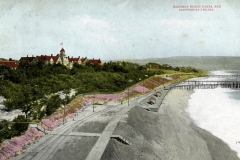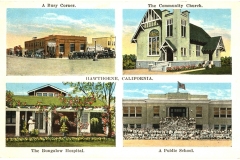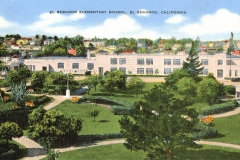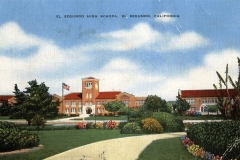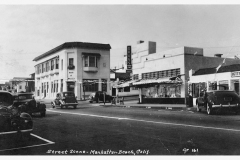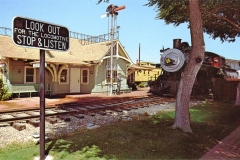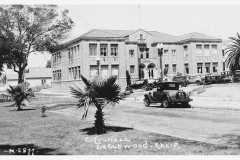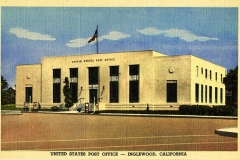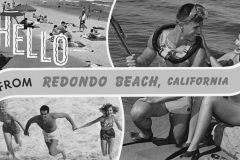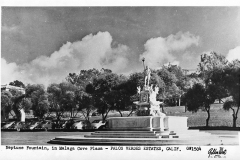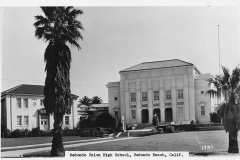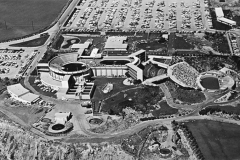History
The History of the South Bay Cities Council of Governments
Historically, the South Bay cities began after the days of the ranchos. The town of Wilmington was founded in 1858 by Phineas Banning as the port, and built up with warehouses, wagon manufacturing shops, and corrals.
The first Southern California railroad was the Los Angeles and San Pedro Railway, opened in 1869 to serve the Wilmington wharves. It ran 21 miles on Alameda Street and the passenger fare was $1.50 one way. The rest of the South Bay was still primarily grazing land. A few small independent cities—Redondo Beach, Gardena, Hawthorne and Inglewood—were founded and survived the land boom period of the 1880s. Redondo Beach was the first city to be incorporated, in 1887.
Roots in Agriculture, Oil and Tourism
The whole area became agricultural. The Beach cities—Manhattan Beach, Hermosa Beach, and Redondo Beach—were tourist locations with early hotels, piers and amusement parks. Redondo Beach was at the end of the Big Red Car line, which extended from Venice. These cities have retained this tourist focus while also being desirable places to live because of the climate and ocean air.
El Segundo, though located on the coast, grew up as a company town for Standard Oil. Even today, it has concentrated development as an office employment center to capitalize on its location abutting Los Angeles International Airport.
The Peninsula began development in the 1920s with the City of Palos Verdes Estates and parts of what are now Rancho Palos Verdes as planned residential communities with limited commercial areas. The same pattern extended over the remainder of the area as the other three cities incorporated (two in 1957 and one in 1973) in order to take control of land use from Los Angeles County. The Peninsula is somewhat isolated from the rest of the sub-region and maintains high income residential neighborhoods and “semi-rural” areas. The eastern portion of the City of Rancho Palos Verdes meets San Pedro, part of the City of Los Angeles, and the harbor.
Expansion into Aerospace
The core of the sub-region, Gardena, Hawthorne, Inglewood, and Torrance, developed throughout the first 40 years of the 20th Century, but really boomed after World War II. The aircraft industry had begun in the area as early as 1915 in Inglewood. Oil was discovered in the Los Angeles area in the 1920s and 1930s and refineries and storage facilities were established in the Wilmington area of Los Angeles, and in Carson, Torrance and El Segundo. Rapid growth in the area was fueled by the conversion of wartime industries into aerospace and related industries. Massive amounts of tract housing were built in the 1950s and 1960s. The cities of Lawndale, Rolling Hills, and Rolling Hills Estates did not incorporate until the 1950s, followed by Lomita in 1964 and Carson in 1968, during the spate of incorporations generally based on the “Lakewood Plan” of contracting for county services. Rancho Palos Verdes was the last to incorporate in 1973.
The area diversified during the 1970s and after with cities like Carson, Torrance, Hawthorne, Gardena, Inglewood, and Redondo Beach developing industrial, office, recreational, and retail centers to serve the growing number of residents. Lawndale, Lomita and the Peninsula cities primarily provided housing for these uses.
South Bay Cities Association Created
In the early 1970s, the South Bay Cities Association (SBCA) was created when the communities of the South Bay began meeting informally to exchange ideas and information regarding inter-jurisdictional issues such as transportation. The association worked to facilitate sub-regional cooperation and coordination of policies and projects.
SBCA was a voluntary organization of South Bay Cities and Los Angeles County. Representation on the SBCA was composed of elected officials (or their designees) from each participating entity. Over the years, however, it became increasingly evident, that informal communication among the South Bay Cities was no longer adequate to meet the newly emerging demands and opportunities facing sub-regions within the Southern California Association of Governments (SCAG) six-county region.
The SBCCOG is Formally Established
In 1992, the SBCA agreed to serve as the sub-regional body to participate in the SCAG Regional Comprehensive Plan process. Funds were provided to hire a consultant team and the project began in the spring of 1993. The SBCA began devoting its time to in-depth discussions of regional and sub-regional issues. In 1994, the South Bay Cities Association formally became a Council of Governments by establishing a legal Joint Powers Agreement (JPA). Its members are Carson, El Segundo, Gardena, Hawthorne, Hermosa Beach, Inglewood, Lawndale, Lomita, Los Angeles (Harbor Gateway/San Pedro areas), Manhattan Beach, Palos Verdes Estates, Rancho Palos Verdes, Redondo Beach, Rolling Hills, Rolling Hills Estates and Torrance.
Starting in 1999, LA County Supervisors Don Knabe and Yvonne Braithwaite Burke provided annual financial contributions to the SBCCOG. The county became an official member of the SBCCOG in 2009, with representatives on the SBCCOG Board of Directors from both Districts 2 and 4.
Name Origins of Our City Agencies
Incorporated in 1968, named after the son of George Henry Carson, John Manuel Carson, a 20th-century developer of the South Bay and head of the Dominguez Water Corp.
Spanish for “the second.” Incorporated in 1917, named by executives from Standard Oil in 1911 as they searched for a location for the company’s second refinery.
Incorporated on September 11, 1930. Reports differ as to how Gardena acquired its name, although it is possible that the name was derived in one of the following ways: One theory is that the name was given by Nettie Thompson, daughter of the man from whom Thorpe bought his subdivision, because the valley was such a beautiful garden spot. Others who have been given the credit were a Mr. Harris, about 1887; a schoolgirl named Lexie Nichols; or perhaps, Spencer Thorpe himself. However, it has also been conjectured that its name was derived from the “Garden Spot,” because of the fertile, green valley created by the nearby Laguna Dominguez slough and channel.
Incorporated in 1922, named after American novelist Nathaniel Hawthorne.
Following the establishment of San Pedro as the main source for the port in Santa Monica in 1897, Los Angeles city leaders argued that direct control over the port areas would be mutually beneficial by providing San Pedro and Wilmington with larger funding and in turn allowing the city to garner more revenue via the increasing port trade. The two cities were initially reluctant to join, but in 1906, frustrated by the indecision of San Pedro and Wilmington leaders, the city of Los Angeles purchased a long and narrow swath of land that connected then-South Los Angeles to San Pedro, naming the two regions Harbor Gateway and Harbor City.
Incorporated in 1907, named after the Spanish word for “beautiful.”
Incorporated in 1908, supposedly named by a visitor from Inglewood, after his home town.
Named by its founder, Charles B. Hopper in 1905 after a Chicago suburb of the same name as a way of attracting settlers from the east.
Although there’s no question that Lomita derives its name from the words Spanish “little hills,” there is apparently some disagreement over just who originally bestowed the name. One source claims Lomita was named by the early promoters of the district as they surveyed it from a hillside in Rancho Palos Verdes. Another source claims that “Lomita del Toro,” or “little hills of the bull,” appears on an early surveyor’s map of Rancho San Pedro, just a few miles east of the present-day city, implying that Lomita inherited its name from the local fauna.
Means ‘the angels’ in Spanish. The city was originally a pueblo founded and named by the Spanish with the full name of: “El Pueblo de Nuestra Señora la Reina de los Ángeles de Porciúncula,” which means “The Town of Our Lady the Queen of the Angels of Porziuncola.”
Named by developer Stewart Miller after his New York hometown. It won a coin flip to become the town’s official name over Shore Acres, the other contender.
Palos Verdes — Spanish for “green sticks”—Estates is this oldest of the four cities on the Palos Verdes Peninsula. Incorporated in 1939, it had been purchased by Frank A Vanderlip from the Bixby family in 1913 with the idea of building a planned, residential community. The name “Palos Verdes” is believed to be named after Canada de Los Palos Verdes, a wooded area near current-day Machado Lake in Harbor Regional Park.
Rolling Hills and Rolling Hills Estates were once part of Rancho El Elastico. The rancho owner, A.E. Hanson, originally planned to name the area Folded Hills, but changed his mind after the Long Beach earthquake in 1933.
Named after the nearby land grant Rancho Sausal Redondo (“Ranch of the Round Clump of Willows”).
Named by Spanish explorer Sebastian Vizcaino in honor of St. Peter, the second-century Bishop of Alexandria.
Named after its founder, Jared Sydney Torrance. Other names considered for the city included Southport, Obrador, Coronel, Don Manuel and Industrial.
Named by developer and entrepreneur Phineas Banning after his home town of Wilmington, Delaware.

